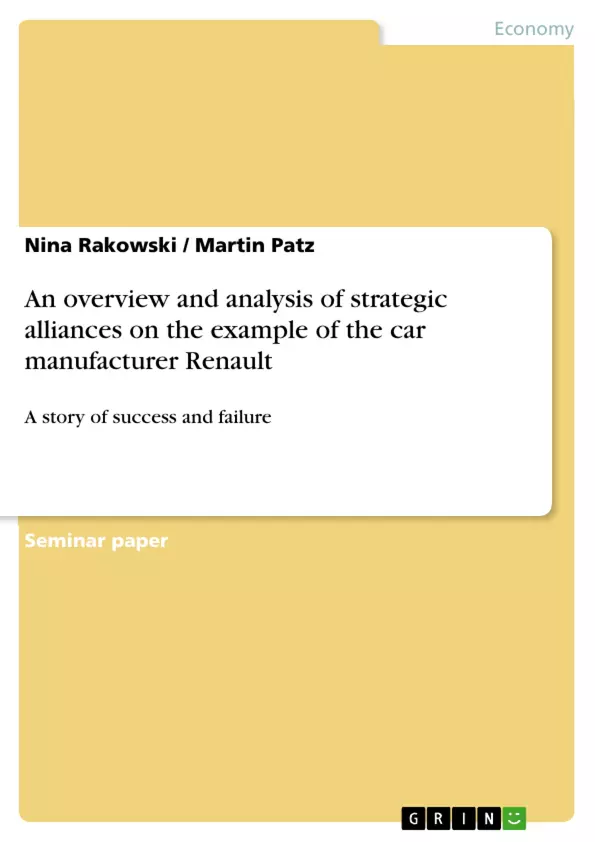[...] There are many different types of partnerships like joint ventures, consortia, licensing,
networks and strategic alliances. For a detailed analysis this work concentrates on strategic
alliances. To give an insight on the topic this work analyses the alliences between the car manufacturers Nissan and Renault and Renault and Volvo. These partnerships are
examples of alliance’s success and failure. On the basis of these examples this work
illustrates the sources of alliance formation and how alliances are able to create competive
advantage but also the reasons why so many alliances fail. Before the case studies of the
above mentioned companies will be discussed this work explains the sources of alliance
formation on a theoretical basis.
Inhaltsverzeichnis (Table of Contents)
- Introduction
- Strategic Alliances
- Definition
- Sources for the formation of Strategic Alliances
- Theoretical approach - the Game theory
- Transaction Cost Economics
- Strategic Positioning
- Organisational Learning
- Resource Based View
- Partner Selection
- The alliance between Renault and Volvo in 1993
- Why the alliance failed
- The alliance of Renault and Nissan
- Renault Nissan: an alliance success
- Conclusion
Zielsetzung und Themenschwerpunkte (Objectives and Key Themes)
This work aims to analyze the factors encouraging the formation and development of strategic partnerships between organizations, using the car manufacturer Renault's alliances as case studies. It examines both successful and failed alliances to illustrate how strategic relationships can create competitive advantage and the reasons for alliance failures.
- Factors driving the formation of strategic alliances
- The role of strategic alliances in achieving competitive advantage
- Theoretical frameworks for understanding strategic alliances (Game theory, Transaction Cost Economics, Resource Based View)
- Case study analysis of Renault's alliances (with Volvo and Nissan)
- Reasons for success and failure of strategic alliances
Zusammenfassung der Kapitel (Chapter Summaries)
Introduction: This chapter introduces the increasing competition in the global business environment, driven by globalization, internationalization, and technological advancements. It highlights the rise of strategic partnerships as a means for companies to remain competitive and emphasizes the importance of such partnerships in creating a competitive advantage through resource and knowledge sharing. The chapter focuses specifically on the automotive industry, noting its heightened competition and the significant increase in strategic partnerships, using a PwC study to illustrate the substantial financial volume of these transactions. The case studies of Renault's alliances with Volvo and Nissan are presented as examples of both success and failure in strategic alliances. The chapter sets the stage for a theoretical exploration of alliance formation before delving into the case studies.
Strategic Alliances: Definition: This section provides a clear definition of strategic alliances, differentiating between equity-based and non-equity-based alliances. It emphasizes that while strategic alliances lead to a collaborative effort toward shared goals, the participating companies retain their independence and strategic autonomy. This section lays the groundwork for the subsequent analysis of Renault's alliances by providing a framework for understanding the nature of such partnerships.
Schlüsselwörter (Keywords)
Strategic alliances, competitive advantage, globalization, internationalization, Renault, Nissan, Volvo, Game theory, Transaction Cost Economics, Resource Based View, organizational learning, partner selection, case study, success, failure.
Frequently Asked Questions: Analysis of Renault's Strategic Alliances
What is the main topic of this document?
This document provides a comprehensive analysis of strategic alliances, focusing on Renault's partnerships with Volvo and Nissan as case studies. It explores the factors driving alliance formation, theoretical frameworks for understanding them, and the reasons for both success and failure in such collaborations.
What are the key themes explored in this analysis?
The key themes include: factors driving the formation of strategic alliances; the role of strategic alliances in achieving competitive advantage; theoretical frameworks (Game theory, Transaction Cost Economics, Resource Based View); case study analysis of Renault's alliances; and reasons for the success and failure of strategic alliances.
What theoretical frameworks are used to analyze Renault's alliances?
The analysis utilizes Game theory, Transaction Cost Economics, and the Resource Based View to understand the dynamics and outcomes of Renault's strategic alliances.
What case studies are included in this analysis?
The document uses Renault's alliances with Volvo (a failed alliance) and Nissan (a successful alliance) as detailed case studies to illustrate the principles and challenges involved in strategic partnerships.
What are the reasons for the success and failure of strategic alliances, as discussed in the document?
While the document doesn't explicitly list all reasons, it implies that factors such as partner selection, strategic positioning, organizational learning, and effective management of transaction costs contribute to success. Conversely, failure may stem from misaligned goals, poor partner selection, or inadequate management of the alliance relationship.
What is the objective of this work?
The main objective is to analyze the factors that encourage the formation and development of strategic partnerships, using Renault's alliances as examples to illustrate how strategic relationships can create competitive advantage or lead to failure.
What are the key takeaways from the Renault-Volvo and Renault-Nissan alliances?
The Renault-Volvo alliance serves as an example of a failed strategic partnership, highlighting potential pitfalls. The Renault-Nissan alliance, conversely, showcases a successful strategic alliance, offering insights into factors contributing to its success.
What types of strategic alliances are discussed?
The document differentiates between equity-based and non-equity-based strategic alliances.
What is the role of globalization and internationalization in the context of strategic alliances?
The document highlights the increasing competition in the global business environment due to globalization and internationalization, emphasizing the rise of strategic alliances as a crucial response to this increased competitiveness.
What are the key words associated with this analysis?
Key words include: Strategic alliances, competitive advantage, globalization, internationalization, Renault, Nissan, Volvo, Game theory, Transaction Cost Economics, Resource Based View, organizational learning, partner selection, case study, success, failure.
- Arbeit zitieren
- Nina Rakowski (Autor:in), Martin Patz (Autor:in), 2007, An overview and analysis of strategic alliances on the example of the car manufacturer Renault, München, GRIN Verlag, https://www.grin.com/document/116048



